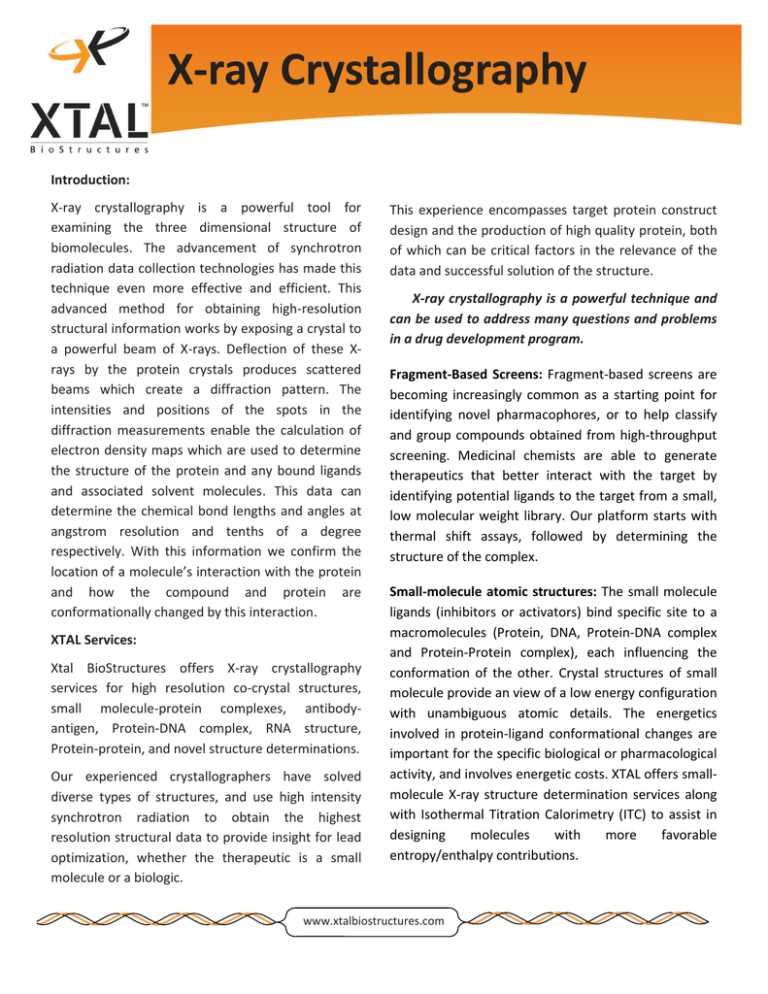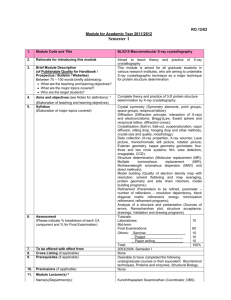X-ray Crystallography
advertisement

Information Technology Solutions X-ray Crystallography Introduction: X-ray crystallography is a powerful tool for examining the three dimensional structure of biomolecules. The advancement of synchrotron radiation data collection technologies has made this technique even more effective and efficient. This advanced method for obtaining high-resolution structural information works by exposing a crystal to a powerful beam of X-rays. Deflection of these Xrays by the protein crystals produces scattered beams which create a diffraction pattern. The intensities and positions of the spots in the diffraction measurements enable the calculation of electron density maps which are used to determine the structure of the protein and any bound ligands and associated solvent molecules. This data can determine the chemical bond lengths and angles at angstrom resolution and tenths of a degree respectively. With this information we confirm the location of a molecule’s interaction with the protein and how the compound and protein are conformationally changed by this interaction. XTAL Services: Xtal BioStructures offers X-ray crystallography services for high resolution co-crystal structures, small molecule-protein complexes, antibodyantigen, Protein-DNA complex, RNA structure, Protein-protein, and novel structure determinations. Our experienced crystallographers have solved diverse types of structures, and use high intensity synchrotron radiation to obtain the highest resolution structural data to provide insight for lead optimization, whether the therapeutic is a small molecule or a biologic. This experience encompasses target protein construct design and the production of high quality protein, both of which can be critical factors in the relevance of the data and successful solution of the structure. X-ray crystallography is a powerful technique and can be used to address many questions and problems in a drug development program. Fragment-Based Screens: Fragment-based screens are becoming increasingly common as a starting point for identifying novel pharmacophores, or to help classify and group compounds obtained from high-throughput screening. Medicinal chemists are able to generate therapeutics that better interact with the target by identifying potential ligands to the target from a small, low molecular weight library. Our platform starts with thermal shift assays, followed by determining the structure of the complex. Small-molecule atomic structures: The small molecule ligands (inhibitors or activators) bind specific site to a macromolecules (Protein, DNA, Protein-DNA complex and Protein-Protein complex), each influencing the conformation of the other. Crystal structures of small molecule provide an view of a low energy configuration with unambiguous atomic details. The energetics involved in protein-ligand conformational changes are important for the specific biological or pharmacological activity, and involves energetic costs. XTAL offers smallmolecule X-ray structure determination services along with Isothermal Titration Calorimetry (ITC) to assist in designing molecules with more favorable entropy/enthalpy contributions. www.xtalbiostructures.com XTAL Macromolecular Structure Determination Pathway Crystal Diffraction Pattern Antibody-Antigen Structures: With the continued importance of antibodies as a therapeutic class, understanding the structure of the bound complex can lead to improvements to the therapeutic by suggesting point mutations that can be made in order to improve it. Structure Guided Drug Discovery: The structure of the ligand target complex can identify the interactions governing the binding and binding site of the ligand. Together, these provide scientific teams with insights that can improve the quality of the therapeutic lead. At XTAL we offer the following structure guided drug discovery services: • • • • • • Crystal screening and optimization Screening for alternate crystal forms Co-crystallization and ligand soaking X-ray data collection Structure determination (target or in complex) Structure interpretation (Integration with MedChem) • Publication/deposit (SBIR, grant applications) • Structure guided design (iterative operations) • Fragment-based screening Electron Density Map Ribbon Diagram Structure Guided Drug Discovery Services from Start to Finish We strive to be Closer to the Science XTAL BioStructures, Inc. 12 Michigan Drive Natick, MA 01760 www.xtalbiostructures.com Email: info@xtalbiostructures.com Phone: 508-318-4674


